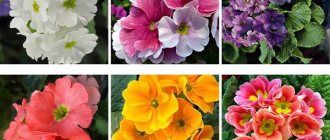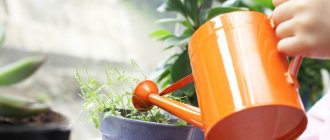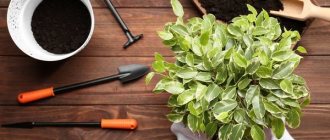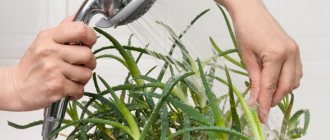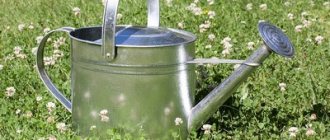What is needed for good growth and flowering of plants.
| For this beautiful clivia to bloom, it needs a period of rest. |
| A wooden plank placed under the pots will protect them from hypothermia on the windowsill. |
All plant life processes depend on temperature. Different plants make their own demands on it, and if they are not met, then we often have to come to terms with the fact that the plant grows poorly and does not please us with flowers.
Under natural conditions, the duration of the growing season is determined primarily by air temperature. When it approaches zero, all life processes of the plant almost stop. Generally speaking, plants can exist at temperatures from - 40°C to + 40°C; plants can tolerate extreme values from this range only in the form of bulbs or seeds, or in a dormant state. Thanks to heating and ventilation, we can provide our plants with an average daytime temperature of about + 20°C; at night it can be a little cooler.
Air temperature and plant growth
All plant life processes depend on temperature. We have already talked briefly about photosynthesis in the chapter “Light and Illumination”.
There is a close connection between the plants' needs for light and heat. It is worth remembering one general rule: the lighter the room, the higher the temperature the plant can withstand. And vice versa: the less light a plant receives, the less its need for heat. It follows from this that in winter, when daylight hours decrease, plants feel better if the average temperature in the room is also lower than in summer. In both summer and winter, plants prefer it to be cooler at night than during the day. And there are reasons for this: in the process of photosynthesis, or, in other words, assimilation, compounds necessary for the plant are created.
At night, another process that is no less important for the plant occurs - respiration, or splitting. The nature of the respiration process is exactly the opposite of photosynthesis. Some of the compounds formed in the light during the day are again decomposed into their component parts at night and used by the plant.
It is very important for a plant that the correct ratio is maintained between the processes of photosynthesis and respiration. This is especially important in winter, otherwise the plant will use up more substances overnight than it can create in a day. The warmer the room, the more substances the plant consumes, so cold-resistant species should be placed in as cool conditions as possible in the dark. If this is not possible, then the plant must be illuminated additionally for many hours every day.
Moderately thermophilic (15-18°C)
These species prefer ambient temperatures in the range of 15-18°C. Usually these are ornamental plants imported from the subtropics.
Here are three striking examples:
- Aloe. A plant with fleshy leaves coming directly from the root. During flowering, flowers appear in red, yellow or orange. Some types of aloe have beneficial properties and are used in alternative medicine.
- Cyperus. An erect stem with an umbrella of long leaves of light green or dark green color at the top.
- Camellia. A perennial shrub with branching shoots and oval or ovoid leaves. Flowering can last for several months. The flowers are large, odorless, white, red, pink or yellow.
Damage to plants caused by temperature disturbances
They can occur on the way home from the flower shop, as well as when airing the room on a frosty winter day. The consequence of this is various growth disturbances, and in some plants that are sensitive to cold, flowers and buds fall off. In the worst case, we can even talk about frostbite: then spots form on the leaves or flowers and the plant tissues die.
A sharp increase in temperature is also detrimental to plants. It is especially dangerous for them, for example, if they are taken from a flower shop in a car hot in the sun. Sooner or later, when the temperature rises above 40°C, damage will appear on the plants. In the immediate vicinity of the window, the sun can also be so hot that the plants will begin to evaporate moisture more strongly and wilt. They may also develop burn marks on leaves or flowers. However, it happens much more often that the temperature in the room for a long time is slightly higher or, conversely, lower than that required by the plant. The consequences of this only appear over time and are quite difficult to recognize. If the room is too cool for the plant, its growth will generally slow down. First of all, the root system stops developing, and the plant begins to suffer from a lack of moisture and nutrients. In addition, its resistance to pests and diseases decreases. Many fungi that cause root rot spread especially at low temperatures, because then the soil dries out very slowly after watering. Therefore, if the average temperature is below normal, the risk of root rot increases.
At high temperatures and insufficient watering, the respiration process occurs more actively, and the plant begins to use up its reserves. This soon leads to the shoots etiolating, that is, becoming faded and frail; the color of leaves and flowers becomes less saturated, and their size decreases.
Choosing dishes for indoor plants
Pots and other containers can enhance the decorative appearance of plants
Pay attention to the following factors when choosing dishes for your plants:. – Suitability for growing plants in it – Will the material of the pot harm humans or the environment – Cost – Strength and durability – Drainage – Weight
– Suitability for growing plants in it – Will the material of the pot harm humans or the environment – Cost – Strength and durability – Drainage – Weight
The style, shape, and size of the container should complement your plants. Small containers are best for small, slow-growing plants, while fast-growing plants will benefit from large and medium-sized containers.
Most often on sale you will find dishes made of terracotta, plastic, or ceramics. Terracotta pots are made from red or yellow fired clay and are very popular today. Plants do very well in such pots, since the porous surface allows for improved air exchange between the plant's roots and the environment. Other clay containers (not terracotta) are available in a range of gray to brown colors, depending on the clay used. Clay pots can be glazed or unglazed. Glazed pots limit air exchange, but amaze with their variety. In unglazed clay pots, moisture evaporates faster, and the plants in them need more frequent watering. Clay containers are inconvenient because they are heavy (especially large pots) and are easy to break or break.
Made from materials such as polyethylene, polyurethane, recycled plastic, and fiberglass, plastic pots range from very simple to quite interesting shapes. Their advantages are that they are light, cheap and quite difficult to break. Air exchange and moisture evaporation in plastic containers is much worse compared to clay containers. Water stays in such pots for a long time, and this can adversely affect the health of indoor plants.
Containers also come with or without drainage holes. Do not allow plants in containers with drainage holes to sit in saucers filled with water for long periods of time. To avoid salt buildup, leach the soil once a month.
Containers without drainage holes are great for plants like Spathiphyllum that need a lot of water, but never use them for cacti or succulents.
What temperature is appropriate?
From spring to autumn, when most plants begin their growth period, the temperature in our apartments is the most suitable for the plant. It rarely falls below normal. On the contrary, in summer a rather different problem arises, because the plants may be too hot near the window.
The situation is different in winter. During this period, different plants have their own temperature requirements. Some of them, despite the decrease in daylight hours, still need warmth, while others enter a period of rest and should be placed in a cool place. Therefore, it is difficult to give any general recommendations regarding temperature. Sometimes even plants belonging to the same family require different conditions.
| Thermometer and hygrometer combined in one device |
Thus, anthurium (Anthurium scherzerianum) and Zantedeschia both belong to the aroid family (Agaceae). For anthurium, the temperature in winter should not be lower than 16°C, and the optimal temperature is an average temperature of 20°C to 22°C. Zantedeschia blooms and develops best at 15°C; if the temperature rises above 18°C, then the newly formed leaves and pedicels fall off. However, some families or groups of plants have similar temperature requirements: Streptocarpus, Gloxinia, Usambara violets and Achimenes belong to the Gesneriaceae family.
All these species are heat-loving, and even in winter they need moderate temperatures. But many cacti should be moved to a cooler room for the winter.
What is the optimal temperature
One of the conditions for the normal development of indoor flowers, delighting with graceful and strong stems, the beauty of openwork foliage and many charming inflorescences, is the creation of an optimal temperature in the rooms used for their cultivation. It may vary depending on the time of year; there are maximum and minimum acceptable values. It is also important to consider what the temperature of the soil in the flowerpot and the water used for irrigation should be.
Temperature in winter
In winter, plants need lower temperatures compared to the summer season. This is explained by the fact that in natural conditions they have adapted to its decrease during this period of the year. The exception is some species that grow in the equator region, where the angle of incidence of the sun's rays practically does not change in different months.
Many indoor flowers are dormant in winter, stop growing, and do not produce new leaves and buds. Simultaneously with the decrease in air temperature, the frequency of watering is reduced, since the evaporation of moisture occurs more slowly and the risk of stagnation of water in the pot increases, which can lead to rotting of the roots.
If you do not provide houseplants with a period of rest, they will be weakened in the spring, develop worse and bloom less.
Here are the optimal temperature values for some species:
- 20–25°C is required for Aglaonema, Zamioculcas, Guzmania;
- 20–22°C – philodendron, dieffenbachia, alocasia, billbergia, vriesia, pineapple, anthurium;
- 18–20°C – coleus, ruellia, fittonia;
- 16–18°C – peperomia, spathiphyllum, syngonium, ivy, caladium, anthurium, phalaenopsis, bromeliad, aphelandra, crossandra, pachistachis, balsam, saintpaulia, zebrina;
- 14–16°C – scindapsus, nidularium, tillandsia, echmea, pelargonium;
- 12–14°C – azystasia, monstera, aucuba, beloperone, cacti;
- 8–12°C – muraya, cypress, nolina, azalea, myrtle, avocado, noble laurel, davallia, shefflera, bougainvillea, trachycarpus, haworthia, cyclamen, cacti;
- 5–8°C – abutilon, agave, yucca, aloe, rose, camellia, cymbidium, hippeastrum, orange, lemon, pomegranate, fuchsia, Washingtonia, dwarf ficus, crassula, feijoa, rapis, oleander, gloxinia.
Guseva Ulyana
Ask a Question
Question to the expert
I have been growing Anthurium Andre at home for 3 years. The plant pleases with its wide glossy leaves, looks healthy, but rarely blooms. Tell me how you can achieve the formation of more buds.
For abundant and long flowering, anthurium should be at rest for about 2 months - from the beginning of November to the first days of January. During this period, the bush should be placed in a room with an air temperature of 15-16°C, reduce the frequency and abundance of watering, and do not use fertilizing. In January, the temperature should be raised to 20–22°C, the application of liquid complex fertilizers should be resumed, and the frequency of watering should be carefully increased, avoiding waterlogging of the soil and stagnation of water.
Temperature in summer
The sun is at its zenith in the summer months, significantly increasing the air temperature. During this period, most plants actively develop, bushes increase in size and bloom profusely. This is facilitated by a higher level of lighting, better air heating, and regular watering.
The optimal temperature for indoor flowers in summer is:
- 20–28°C – for Dieffenbachia, Anthurium, Tillandsia, Cordyline;
- 22–26°С – for Vriesia, Alocasia, Aechmea;
- 20–25°C – for aglaonema, crossandra, pachystachys, ruellia, fittonia, peperomia, aspidistra, bromeliad, guzmania, balsam, pineapple, aphelandra, streptocarpus, codiaum;
- 18–24°C – for nidularium, monstera, caladium, beloperone, aucuba, saintpaulia.
Plants that can be placed in a very warm and very cold room
Depending on what temperature conditions plants require, gardeners divide them into three groups: cold-resistant plants; plants that prefer moderate temperatures and heat-loving plants. Most indoor plants belong to the second group: they require an average temperature of 15°C to 20°C. Below is a table of plants that can be placed in a very warm or very cold room.
| Allamanda Aphelandra Blechnum Dieffenbachia Beloperone | Allamanda cathartica Aphelandra squarrosa Alechnum gibbum Dieffenbachia-Arten Justicia brandeaeana | |
| Cold-resistant plants (withstand temperatures of 10°C - 15°C) | Campanula Chlorophytum Cordyline Primula, primrose Saxifraga | Campanula Arten Chlorophythum comosum Cordylina indivisa Primula-Arten Saxifraga |
Recommendations
Useful tips that will help you achieve a normal temperature:
- It is strictly not recommended to purchase indoor plants in frosty weather, since due to a sharp temperature change (from a warm room to the street), it can catch a cold and die.
- It is not advisable to transport indoor plants in the trunk of a car. Even if you transport a flowerpot with a “green friend” in your hands, it is better to cover it with protective packaging.
- Almost all purchased plants have a label indicating the optimal temperature regime.
- Experts do not advise placing a pot with a plant between the window glass and a drawn curtain in winter. This can lead to a sharp change in temperature and illness of the “green friend”.
5/5 — (1 vote)
In summer - fresh air
Among indoor plants there are many that will feel especially good if they spend the summer outdoors. From May until the first frost they can stand on the balcony, terrace or in the garden. Agaves, some types of palm trees, oleander, hibiscus, myrtle, bougainvillea and citrus trees do especially well in the sun. Azalea, hydrangea, abutilon or camellia are suitable for shady places. Plants from both of these groups require a lot of light, they tolerate the heat of the sun and the coolness of the night well, and are so hardy that they are not harmed by a light breeze or even temperatures close to zero. Heat-loving plants and plants with especially delicate leaves, such as Usambara violets, caladium or tall begonia, should not be exposed to fresh air. If you follow a few basic rules, you will not encounter any difficulties when moving plants into the garden in the summer.
| During the dormant period, you should “almost forget” about clivia - then in the spring it will delight you with lush flowering. |
| Sunburn on clivia leaves. In the warm season, clivia feels good in mild sun or partial shade at a temperature of about 20°C. |
| Plants should be taken outdoors in cloudy and windless weather. In the first few days they should not be exposed to the sun! |
Choose the right time.
When to move plants outdoors depends mainly on temperature. Of course, already in March, on the first warm days, they can be put outside, but they must definitely be brought back at night. You can leave them to spend the night outside only after the threat of frost has passed, that is, somewhere in mid-May. If the weather is too cool, you will have to wait another two or three weeks.
Let the plants get used to the new place.
The conditions in which the plant was in the room are very different from those in which you placed it now. After all, it is much lighter outside, the plant can be exposed to direct sunlight, not to mention the fact that at night the temperature drops significantly lower than in the apartment. Therefore, we advise you to accustom the plant to these new conditions gradually.
If possible, bring him back into the house during the first nights. Do not forget that even sun-loving plants should not be left in the hot midday sun at first; it is better to place them in a shaded place protected from the wind.
Features of care.
Of course, if necessary, the plants should be watered and fertilized. Plants exposed to rain must have pots with a drainage hole. You can bury pots of plants somewhere in the garden up to the very edges, and then there will be no need to water them separately. It is very important to regularly check to see if any pests have appeared on the plants. On the street you have to be much more wary of even those pests that are extremely rare in the room, such as a slug or a grape elephant.
Returning plants to the home.
This should not be delayed until the first frost; it is better to move the plants into the house in advance. Do not immediately bring the plants into a well-heated room, but rather first place them in some cool and as bright place as possible, for example, in the hallway or bedroom. Check again to see if they are infested with pests. If minor damage was still acceptable outside, now the plants must be completely healthy, otherwise there will be a danger of infection of the rest of the plants in the room.
Temperature on the balcony in winter
Let's start with the fact that the balcony (loggia) where you are going to grow flowers in winter must be glazed and preferably well insulated. The double-glazed window must have 2 glasses, all cracks (if any) must be carefully sealed with sealant.
On an insulated balcony, the temperature is approximately 8-10 °C higher than outside. If not insulated, the temperature difference is about 5 °C. And if the balcony room faces the sunny side, then during the day in good weather the difference will be even greater.
In addition, the temperature at different levels of the balcony also varies. If at the level of the window sills it stays, say, around 10 °C, then at the floor level the temperature will not rise above 4-5 °C. And under the ceiling it can reach 14-15 °C.
Plants that prefer coolness in winter
Some of the indoor plants with decreasing daylight hours, that is, from November to February, should be kept in as cool a room as possible. These include some species that prefer to spend their summer outdoors, such as agave, date palm, myrtle, oleander, fuchsia or hydrangea. Cacti or clivias need a period of dormancy in the winter in order to bloom again in the spring. You will read more about this in the chapter “Blooming and re-blooming”
. For winter, it is better to place the plants in a bright room with a temperature of 5°C to 10°C. Under these conditions, the vital processes of the plant are reduced to a minimum, and growth practically stops. In accordance with this, watering is reduced or stopped completely. Plants should not be placed in direct sunlight or in a well-heated room, as this will interrupt the dormant period. As a room for overwintering plants, you can use a bright basement (but not heated!), a cool hallway, a bedroom or, ideally, a greenhouse.
Thermal regime rule
Houseplants require relatively constant and moderate temperatures during the growing season and cooler temperatures during the dormant period.
Based on materials from the book “Flowers all year round”, (c) 1998 “Lick-press”
Acclimatization
Acclimation is the adaptation of a plant to a new environment and is very important for the healthy growth of houseplants. In greenhouses, plants are accustomed to bright lighting, constant feeding, optimal watering, temperature and relative air humidity that meet their requirements - in general, ideal conditions for their growth (Fig. 6). Residential homes, with poorly lit rooms and low relative humidity, are likely to produce a poor impression on plants - the greater the differences between the old environment and the new home environment, the more negative factors will affect the plants.
Figure 6. Two sides of acclimatization - aboveground (light acclimatization) entails adaptation to low light, which means reduced growth and reduced nutrient requirements. Underground (soil acclimatization) entails a reduction in nutrients and water.
As a rule, acclimatization occurs in a greenhouse or nursery. Plants are specially grown for some time in low light and with fewer nutrients. Because this slows the growth of acclimatized plants, plants are marketed later than non-acclimatized plants. And acclimatized plants are more expensive compared to non-acclimatized plants, but for more money you will not have to face a number of problems in the future. Figure 7 and Table 1 show the traits and appearance of acclimatized plants.
Figure 7. Acclimatized Ficus benjamina; Large, dark green leaves and elongated internodes are noticeable here.
To acclimate plants at home, place newly purchased plants in a brightly lit area for at least 3 to 4 weeks and then place them in a permanent location. Porches and patios are ideal brightly lit places for your plants during the warmer months, as long as the plants are not exposed to direct sunlight. The most common phenomenon inherent in plants placed indoors is leaf drop. But this is a temporary phenomenon, and it stops a few weeks after the plant has settled into its new location. However, keep in mind that if you move the plant again, the acclimatization period will begin again, and similar phenomena will also repeat.
When purchasing, always ask about the degree of acclimatization of the plant you are purchasing. The seller must provide you with this information. So, when purchasing a plant from a garden center, always ask if it has been acclimatized.
Remember that the most important factors for the successful growth of indoor plants are adequate lighting, fertilizer, and watering.
Table 1. Traits of acclimatized plants compared to non-acclimatized plants.
| Acclimatized plants | Non-acclimatized plants |
| medium to dark green leaves | yellow or light green leaves |
| large leaves | small leaves |
| flat leaves | slightly curved leaves |
| thin leaves | thick leaves |
| sparse foliage | dense foliage |
| long internodes | short internodes |
| medium or thin stem | thick stem |
| horizontal or slightly bent position of the sheet | vertical position of the sheet |
| few new leaves | a lot of new leaves |
| wide angles of processes | sharp corners of the processes |
